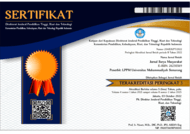Pelatihan Penggunaan ‘Kahoot’ dalam Mengajar Reading Narrative bagi Siswa Kelas X SMA Veteran 1 Sukoharjo
(1) Universitas Veteran Bangun Nusantara
(2) Universitas Veteran Bangun Nusantara
(3) Universitas Veteran Bangun Nusantara
(4) Universitas Veteran Bangun Nusantara
(5) Universitas Veteran Bangun Nusantara
(*) Corresponding Author
Abstract
During this pandemic, all sectors have collapsed, even the education sector, which is accustomed to face-to-face classes, has become mandatory for offline or online classes, so English teachers are also required to be more creative in developing learning media. Although English is a compulsory subject, the results attained from English subject are not very satisfying. Learning activities is one of the stages that determines the success of student learning. The quality of education and teaching can be enhanced by optimizing several elements such as students, teachers, learning indicators, lesson content, methods, media, and evaluation. Because of the importance of reading material for students, the Bangun Nusantara Sukoharjo Veteran University service team offers Kahoot application training for class X SMA Veteran 01 Sukoharjo. The method utilizsd in this method is a quiz that is taught to class X students according to the lesson plans and syllabus of class X students, as well as the reading material given. The target to be achieved from this service is to increase knowledge and instruction about reading training using Kahoot media for class X SMA Veteran 01 Sukoharjo. In addition, this dedication is expected to be able to achieve several things, nemely: (1) the teacher knows more about the ability of each student in reading comprehension; (2) teachers can think logically and systematically by utilizing existing media in answering quizzes through reading training; (3) students are assisted in learning to think from a point of view in thinking practice; (4) teachers can further develop students' motivation to learn; and (5) students are actively involved in class planning and management.
Full Text:
PDFReferences
Basuki, Yudi & Hidayati, Y. N. (2019). Kahoot! Or Quizizz: the Students’ Perspective. In Proceedings of the 3rd English Language and Literature International Conference (ELLiC) (pp. 202–211). Semarang: Faculty of Foreign Language and Culture Universitas Muhammadiyah Semarang. Retrieved from https://books.google.co.id/books?id=jFAIEAAAQBAJ&printsec=frontcover&dq=Ellic+2019&hl=id&sa=X&ved=2ahUKEwjPr-CW_IzvAhXQXSsKHZ3iBmoQ6AEwAHoECAEQAw#v=onepage&q=Ellic%202019&f=false
Brown, Douglas H. (1987). Principle of Language Learning and Teaching. Englewood Cliffs, New Jersey: Prentice Hall Regents.
Chiang, H. (2020). Kahoot! In an EFL Reading Class. Journal of Language Teaching and Research, 11(1), pp. 33-44. Retrieved from https://www.academypublication.com/ojs/index.php/jltr/article/view/jltr11013344
Hymes, Dell. (1988). Foundation in Sociolingusitics: an Etnographic Approach. Philadelphia: University of Pennsylvania Press.
Irwan, I., Luthfi, Z. F., & Waldi, A. (2019). Efektifitas Penggunaan Kahoot! untuk Meningkatkan Hasil Belajar Siswa [Effectiveness of Using Kahoot! to Improve Student Learning Outcomes]. PEDAGOGIA: Jurnal Pendidikan, 8(1), pp. 95-104. Retrieved from https://ojs.umsida.ac.id/index.php/pedagogia/article/view/1866
Licorish, S. A., George, J. L., Owen, H. E., & Daniel, B. (2017). “Go Kahoot!” Enriching Classroom Engagement, Motivation and Learning Experience with Games. In Proceedings of the 25th International Conference on Computers in Education (pp. 755–764). Semarang: Faculty of Foreign Language and Culture Universitas Muhammadiyah Semarang. Retrieved from https://www.researchgate.net/profile/Sherlock_Licorish/publication/322150947_Go_Kahoot_Enriching_Classroom_Engagement_Motivation_and_Learning_Experience_with_Games/links/5a484fd80f7e9ba868ab622d/Go-Kahoot-Enriching-Classroom-Engagement-Motivation-and-Learning-Experience-with-Games.pdf
Licorish, S. A., Owen, H. E., Daniel, B., & George, J. L. (2018). Students’ perception of Kahoot!’s influence on teaching and learning. Research and Practice in Technology Enhanced Learning, 13(9). Retrieved from https://telrp.springeropen.com/articles/10.1186/s41039-018-0078-8
Plump, C. M. & LaRosa, J. (2017). Using Kahoot! in the Classroom to Create Engagement and Active Learning: A Game-Based Technology Solution for eLearning Novices. Management Teaching Review, 2(2), pp. 151-158. Retrieved from https://journals.sagepub.com/doi/full/10.1177/2379298116689783
Rivers, W. (1993). Communicating Naturally in a Second Language. Cambridge: Cambridge University Press.
Wang, A. I. & Tahir, R. (2020). The effect of using Kahoot! for learning – A literature review. Computer & Education, 149, 103818. Retrieved from https://www.sciencedirect.com/science/article/pii/S0360131520300208
Wardhaugh, Ronald. (1998). An Introduction to Sociolinguitics. Oxford: Blackwell Publishers Ltd.
Article Metrics
Abstract view : 610 timesPDF - 173 times
DOI: https://doi.org/10.26714/jsm.3.2.2021.134-142
Refbacks
- There are currently no refbacks.
Copyright (c) 2021 Jurnal Surya Masyarakat

Jurnal Surya Masyarakat (JSM) is licensed under Creative Commons Attribution-NonCommercial-NoDerivatives 4.0
------------------------------------------------------------------------------------------------------------------------
Jurnal Surya Masyarakat (JSM)
p-ISSN: 2623-0364; e-ISSN: 2623-0569
Published by: Lembaga Penelitian dan Pengabdian Masyarakat (LPPM) Universitas Muhammadiyah Semarang



.jpg)







.jpg)